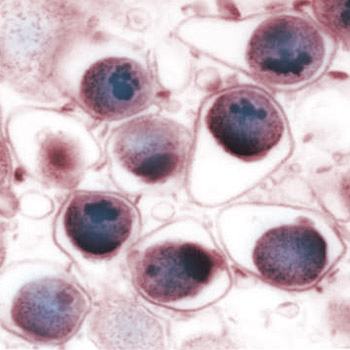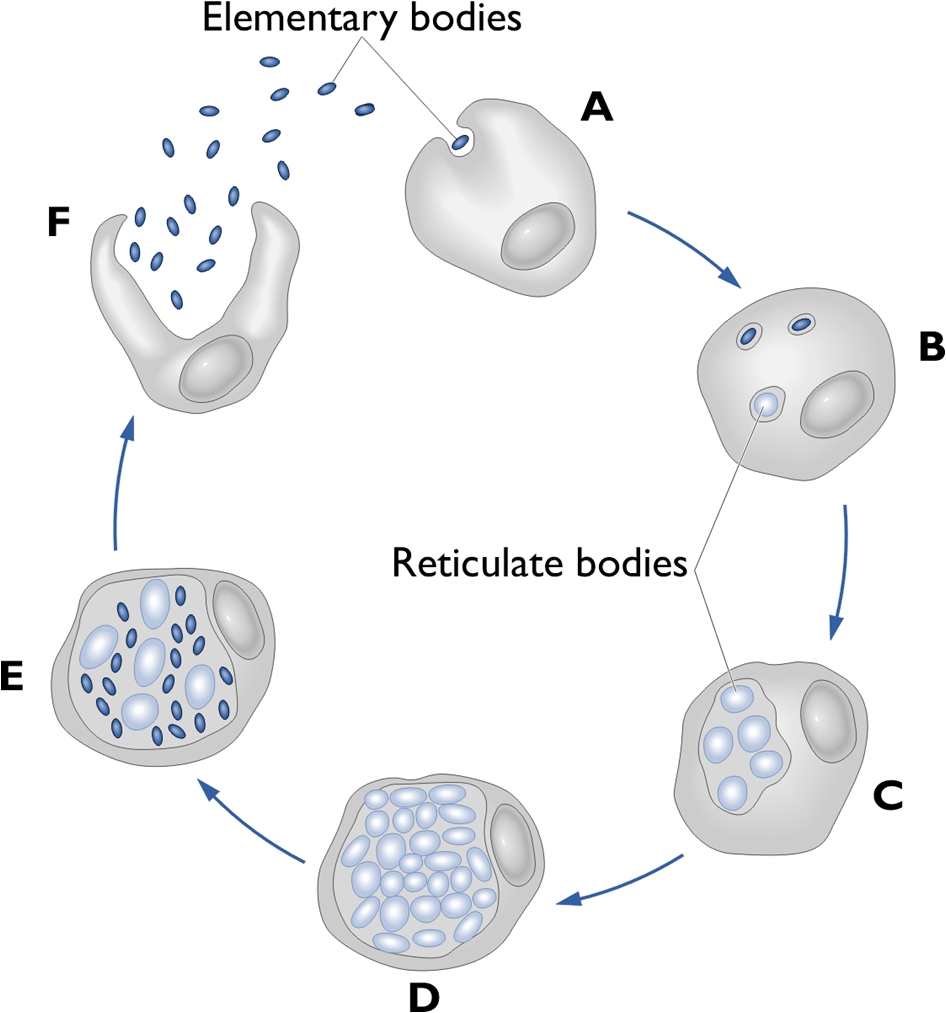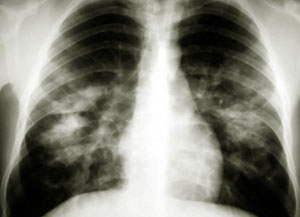Chlamydophila pneumoniae
Chlamydophila pneumoniae in epithelial cells: 1 - infected epithelial cell, 2 - uninfected epithelial 3 - C. pneumoniae as reticulate in the cell, 4 - Nuclei
Chlamydophila pneumoniae (formerly known as Chlamydia pneumoniae ) is a bacterium that can infect humans and cause pneumonia. They are a type of chlamydia. Chlamydophila pneumoniae has a complex life cycle and must infect another cell in order to reproduce themselves can. In addition to the role in lung inflammation, there is evidence that the pathogen may be associated with atherosclerosis and asthma. The complete DNA sequence of the genome was published in 1999.
Life cycle and methods of infection
Chlamydophila pneumoniae is a small gram-negative bacterium that undergoes a series of transformations in his life. It exists as an elementary body ( EB) between biological host systems. The EB is metabolically inactive, only 0.2-0.3 microns in size, but is resistant to the environment ( eg, osmotic changes ) and can also survive outside the host system. EB traveling from an infected person to the lungs of a non- infected individual as small droplets, and causing the infection. In the lungs arrived is received by the EB ( epithelial ) cells in a kind of pouch ( Membraneinschluß ) called the endosome, this process is referred to as endocytosis. However, the EB is not destroyed by the fusion with lysosomes, which is typical for phagocytosed material. Instead, he transforms into a reticulate bodies (RB ), which has a size of 1 micron, and begins to multiply within the endosome. The RBs have to use a part of the machinery of the host cell in order to complete their growth. The reticulate bodies then develop elementary bodies back to be released back into the lungs, often causing thereby the death of the host cell. The EBs are then able to infect new cells, either in the same organism or in a new one. Therefore, the life cycle of Chlamydophila pneumoniae is divided into the EB, the only cause infections, but can not replicate, and the RB, which can proliferate, but can not cause new infections.
Pneumonia, arthritis, tendonitis by Ch pneumoniae
Chlamydophila pneumoniae is a common cause of pneumonia defense weakened people worldwide. Chlamydophila pneumoniae is typically transmitted via air ( over the air ). In most infections run without any complaints or in the form of slight sore throat. The Chlamydia can 4-6 weeks after primary infection leading to post-infectious arthritis and tendonitis. Most constitutes neither the doctor nor the patient between the possibly symptomatic primary infection and the joint connects. It is based on a 50-70 % strength prevalence of the population with Chlamydophila pneumoniae. This high prevalence indicates a linger in the body for several years. Because the treatment and diagnosis proceeded historically different names are used as Chlamydia pneumoniae and one speaks of an atypical pneumonia.
Symptoms and Diagnosis
Mostly run infections asymptomatic and unnoticed or cause slight sore throat. If, in debilitated persons for pneumonia, symptoms of infection with Chlamydophila pneumoniae not from those of another pneumonia ( cough, fever and shortness of breath). Chlamydophila pneumoniae cause frequent sore throat, hoarseness and sinusitis than other types of pneumonia, but other types of pneumonia also have these symptoms. Thus, a discrimination is not possible. Normally, a doctor is not in a position only on the basis of the symptoms to make a definite diagnosis.
The diagnosis of Chlamydophila pneumoniae can be detected by examination of the sputum or secretions of the pharynx. A blood test can show antibodies against the bacteria. But if there was a previous infection, the antibodies may also therefore originate. Therefore, an analysis of the antibodies after 6 weeks is necessary to diagnose a new or old infection. The blood test can also proteins (antigens) of Chlamydophila pneumoniae show, either by a direct fluorescent antibody testing, and enzyme-linked immunosorbent assay ( ELISA) called, or polymerase chain reaction (PCR).
X-ray images of the lungs infected with Chlamydia pneumoniae, often exhibit a small spot of an enhanced shadow ( opacity ). However, it is also here, different patterns, so that no clear analysis is also possible here.
Treatment and chances of success
Typically, the treatment is started before the microorganism has been identified, at least when a known disease is apparent. This general therapy involves an antibiotic for atypical bacteria, which also include Chlamydophila pneumoniae. Since many of pneumonia and inflammation of the arterial system run eg without severe symptoms, it is usually possible only after more detailed investigations secretion, to find a suitable therapy. Because of the problem of the different states of Chlamydophila pneumoniae also each have a different form of therapy is necessary for the individual phases, since it is pointless to use an antibiotic for the reticulate bodies, which is not effective against the elemental form, otherwise after stopping the elementary body back into RB convert and the disease begins anew. Therefore, it will in future have to give an effective antibiotic therapy in the form of a combination agent, at least one combination that captures the dormant forms.
The most commonly used antibiotics are macrolides such as azithromycin or clarithromycin. If a test Chlamydophila pneumoniae clearly shows the cause, the Therapierung can shake gently to Doxycycline, which is less side effects and slightly more effective against this bacterium. Sometimes a quinolone antibiotic levofloxacin, is used as the start of a therapy, but has more side-effects. The treatment usually lasts 10 to 14 days. In a post-infectious arthritis or tendonitis Chlamydophila pneumoniae is inhibited most efficiently in vitro by clarithromycin. Here antibiotic therapy for 30-90 days must be performed.
The prognosis of pneumonia caused by Chlamydophila pneumoniae is good. Hospital stays are atypical, rare complications and most patients have no after-effects after recovering from illness. However, the elementary bodies usually survive, at least for the time being the initial symptoms disappear. Chlamydophila pneumoniae is, however, becomes chronic, the body so it does not create itself, to eliminate the elementary body, the danger of creeping diseases of the circulatory system is so significant.
Epidemiology and prevention
Chlamydophila pneumoniae affects all age groups and occurs most frequently in the group of 60 - 79jährigen ago. Re-infection after a short time of the immunity is common. In younger people, the infection often remains ( high Durchseuchungsgrad ), but no longer occurs usually long in appearance. After a long period may, for example, but a chronic Chlamydophila pneumoniae result of which then in different forms again manifests itself (arthritis, arteriosclerosis, etc.). The prevalence is estimated at 50-70%. The incidence of pneumonia is a person of a thousand people a year, affecting approximately 10% of all pneumonia without hospitalization.
For diseases of the circulatory system is, however, to suspect on the findings of recent years that a significantly larger number is due to Chlamydophila pneumoniae. Just atherosclerosis and its consequences (heart disease, stroke, etc.) may be induced primarily by Chlamydophila pneumoniae, it is increasingly more and more studies suggest.
In hospitals Chlamydophila pneumoniae competes due to the very similar symptoms with MRSA, where doctors tend to focus more on the treatment of MRSA. As a result, more and more resistance from Chlamydophila pneumoniae, among others, doxycycline and erythromycin arise.
In 2011, there was no inoculation. In addition to good hygiene, there are no preventive measures.
Asthma
Bronchial asthma, as well as exacerbations of this disease are often associated with the serological detection of Chlamydia pn .. The symptoms may respond to a therapy well with macrolides.
Other diseases that cause Ch pneumoniae
In addition to pneumonia caused Chlamydophila pneumoniae other diseases, which is the subject of several investigations at the time. These include meningoencephalitis, arthritis, BOOP ( bronchiolitis obliterans with organizing pneumonia ), myocarditis and Guillain- Barré syndrome. It has also been associated with dozens of other diseases linked, such as Alzheimer's, multiple sclerosis, fibromyalgia, chronic fatigue syndrome, prostate problems and many others.
Connections between Ch pneumoniae and chronic diseases
In addition to previously known acute infections Chlamydophila pneumoniae has been implicated in other chronic diseases. There is evidence that the onset of asthma may be associated with Chlamydophila pneumoniae. However, there was until 2005 no proof.
Chlamydophila pneumoniae infections with connections to and heart attacks were found. In fact, the bacterium was demonstrated, inter alia, in the coronary arteries. Antibodies are also higher in people with heart problems. Also in stroke patients repeated signs of chronic infection with Chlamydophila pneumoniae could be detected. It is believed that chronic infection with the pathogen contribute to the development and progression of atherosclerosis and play a role as in heart attack and stroke. Indian researchers and physicians at the University of Munich have now found that it came to a decline in heart attacks in conjunction with Chlamydophila pneumoniae after administration of suitable antibiotics and even narrowing of the coronary arteries regressed.
Credentials
- Kalman, S et al. In 1999. Comparative genomes of Chlamydia pneumoniae and C. trachomatis. Nature Genetics 21:385-389 PMID 10,192,388
- O'Connor S, et al. Potential Infectious etiologies of Atherosclerosis: A Multifactorial Perspective. Emerging Infectious Diseases, Vol 7, Sept -Oct 2001
- Hahn DL, Dodge RW, Golubjatnikov R. Association of Chlamydia pneumoniae ( TWAR ) infection with wheezing, asthmatic bronchitis and adult -onset asthma. JAMA 1991,266:225-30.
- Cannon CP, Braunwald E, McCabe CH, Grayston JT, mill stone B, Giugliano RP, Cairns R, Skene AM; Pravastatin or Atorvastatin Evaluation and Infection Therapy - Thrombolysis in Myocardial Infarction 22 Investigators. Antibiotic treatment of Chlamydia pneumoniae after acute coronary syndrome. N Engl J Med 2005 April 21; 352 (16 ) :1646 - 54th PMID 15843667
- Klaus- Armin Bartsch: Preparation of activated NF -kB in the atherosclerotic lesion










